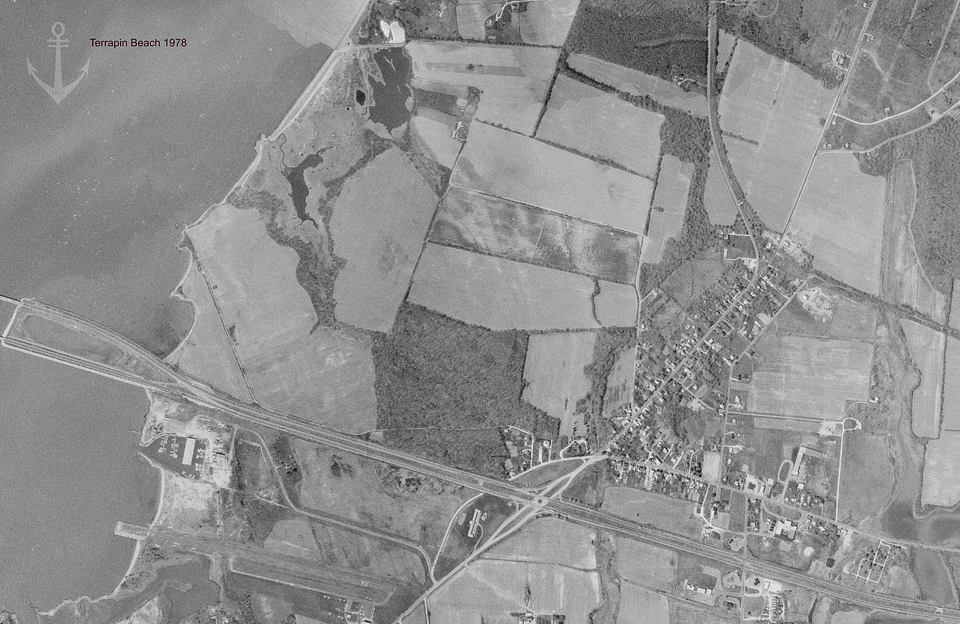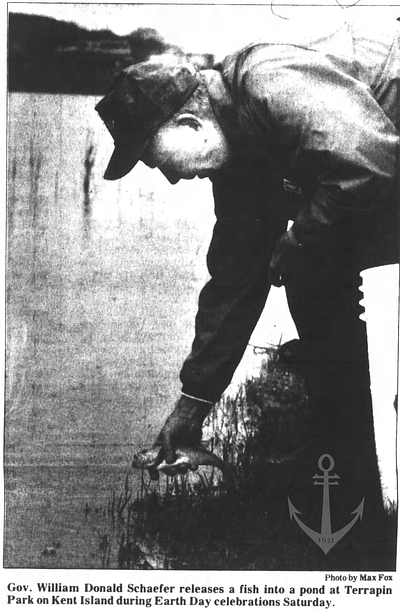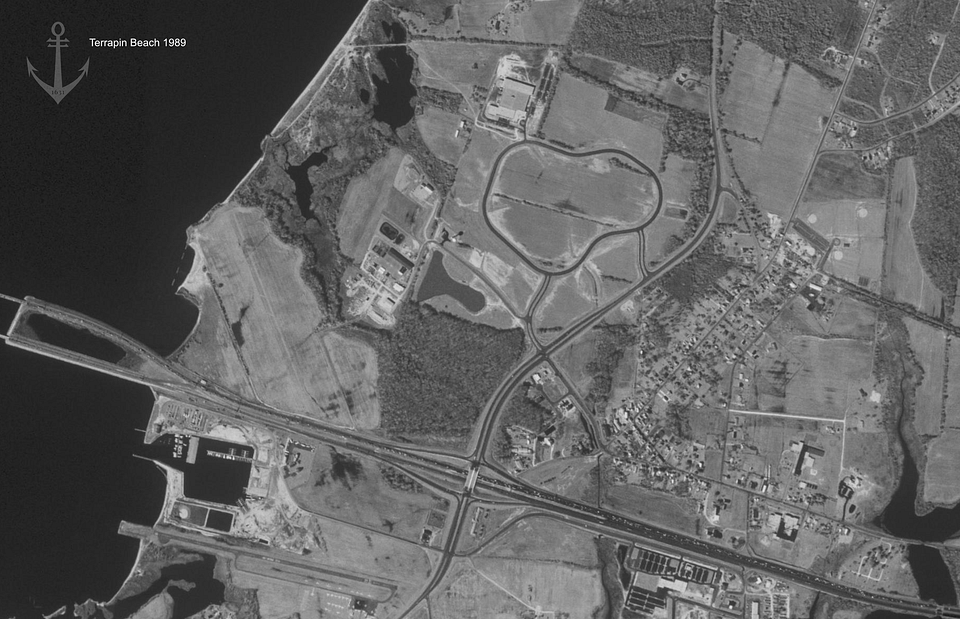On November 15, 1983, after a six-year saga to develop Terrapin Beach, Queen Anne’s County (QAC) purchased the farm from Terrapin Beach Limited Partnership for a little over $1.5 million. They designated 294 acres to open space for the County’s first public beach, 12.9 acres for a sanitary district, and rezoned 159 acres for the County’s first business park. The County Commissioners, Recreation & Parks, and the Economic Development Commission (EDC) began devising a master plan for the property in cooperation with the state of MD. This was the beginning of the Chesapeake Bay Business Park and Terrapin Nature Park.
County Administrator Bob Sallitt stated the land purchase marked five years of efforts to attract industry to QAC, generate employment on Kent Island, and preserve the natural bay area shore. The envisioned open space aimed to become a wildlife preserve with nature trails and jogging paths, distinctly different from Sandy Point Park. The business park was intended to attract high-quality, environmentally friendly industries that would not compromise the preservation of the Bay.
On February 7, 1984, the County hired Prahful Shah and Associates to conduct a 90-day feasibility study for the business park land. The study aimed to uncover its economic potential and identify practical development sites. Its results would aid in securing financing from federal and state sources for the Chesapeake Bay Business Park.
Joseph Downey, vice chairman of the EDC, emphasized the need to plan various infrastructure elements like sewer, water, fire protection, access roads, drainage, and electrical services, as well as landscaping. Then they could begin their search for ideal businesses to fill the industrial park such as “high-tech industries … (so) we won’t have any smokestacks.” Construction was to begin by late 1984, with industry occupancy expected in 1985-86.
With part of the farm property now slated to host a business park, the old road to Terrapin Beach became obsolete and a hub for teenage gatherings, vandalism, and littering. On February 21, 1984, the Commissioners started closing a 500-foot section of Cockey’s Lane, also known as Back Lane among the locals. The remaining stretch behind present-day Amalfi Coast in downtown Stevensville still extends northwest towards the business park.
The business park’s potential captivated the Japanese Consulate General. In March 1984, they flew into the Kent Island Airport for a three-day visit. They explored the Eastern Shore’s opportunities, including the growing sophistication of the local farm community, and discussed bilateral trade relations with the U.S. This was a great start for the County’s goal of attracting international business to the island.
Unsafe access significantly challenged the County’s business park plan. Before the Route 8 overpass was built, Route 50/301 intersected with Old Love Point Road near downtown Stevensville via a hazardous cloverleaf intersection. The only access to the Terrapin property was the previously mentioned Cockey Lane or Cable House Road, neither of which is connected today. Fortunately, on August 15, 1984, the MD State Highway Administration (SHA) started a two-year overpass interchange project, coinciding with the business park’s development. This project resolved the access issue and provided a safer route for the local community.
Following the business park feasibility study, attention shifted to designing and developing the 260-acre Terrapin nature area. The County’s top priority for the park was solving the major erosion problem along the bay shore. In December 1984, they sought a $450,000 state grant for a $600,000 solution involving rip-rap and plant vegetation to combat the Bay. To raise additional funds, the County leased 125 acres of cropland to farmers and sold fill dirt to contractor David A. Bramble, Inc. for the Route 8 overpass construction.
Kent Island Boy Scout Troop 495 tested the new nature area, hosting the first (and what seems to be the only) Kent Island Camporee there on April 19, 1985. The event brought together 179 Boy Scouts, Webelos, and Scout Masters from the Delmarva and Washington area. Over two nights at the park’s beach, they took part in various competitions, including Walking Big Foot, Happy Homemaker, Remove the Isotope, First Aid, Four Legged Race, and Orienteering.
By May 1985, the county had secured a $1.5 million dollar low-interest MILA loan for infrastructure development. In November, Recreation & Parks Director Steve Walls requested $572,000 from the Department of Natural Resources (DNR) to upgrade shoreline protection guidelines from vegetation to stone revetments because of powerful Bay waves. The funds would also support tidal inlet restoration, shoreline cleanup, landscaping, walkway and bridge construction, and an earthen dam.
In my research, I’ve noticed a crucial absence in QAC today. That is the desire for responsible development. Back in January 1986, island residents emphasized the need to preserve Terrapin’s natural beauty during a public hearing. They feared it would become another Sandy Point Park. Business park developer John Hall from Land Design Research echoed the sentiment, replying “All the suggested uses for it were oriented towards protecting that.” County representatives also unanimously supported this approach for the project.
County Commissioner President Oscar “Sonny” Schulz made a noteworthy statement that challenges current perspectives on Terrapin Park’s use. He stressed, “This is primarily a park for county residents. The county owns the land and we want to see it utilized by them.” He added, “Although the nature park would be open to all state residents, no special attempts would be made to advertise the park’s existence on the Route 50/301 corridor.” This stands in stark contrast to the present approach to Terrapin Park and island development.
The original Terrapin Park master plan, presented at the public hearing, outlined paved trails, camping and picnic areas, waterfowl feeding zones, a lake, a wildflower meadow, and an environmental education center. It aimed to restore several old farm buildings, a gazebo, and a cemetery, and incorporate 60 acres of leased farmland. Construction began in late summer 1986, but regrettably, fewer than half of these elements would come to fruition.

Construction of the Chesapeake Bay Business Park began on June 5, 1986, which included roads, curbs, and utility lines. By December, half of the initial infrastructure work was complete, but challenges arose. Contractor David A. Bramble was facing $300 daily fines for a one-month delay and the pumping station bid came in at twice the estimated amount because of iron-rich water. Any islander on well water can relate. Originally set for completion in the early summer of 1987, the project’s timeline was extended to September, with the second phase expected to conclude in October.
Meanwhile, on May 26, 1987, the county sold Lot 7 to Edmund and Clyde Sisk, making Sisk Mailing Service, a high-tech mailing firm, the first company to enter the park. They were eager to break ground on their facility and aimed to begin by July 1.
On June 2, 1988, the County hosted its Development Conference, where they proudly unveiled the completion of the Chesapeake Bay Business Park. While Sisk Mailing Service stood as its sole occupant, this achievement allowed the marketing and sale of the remaining lots, with the exciting prospect of generating approximately 2,400 job opportunities.
Attention turned to Terrapin Park’s future with a new proposal from MD SHA. They introduced constructing a $6.2 million Chesapeake Bay Information Center on 8 acres of critical area property next to the westbound span of Route 50/301. This one-story, 5,000 square foot building overlooking the bay would serve as a tourism hub, house a Chesapeake Bay exhibit, and host meetings. The debate centered on land use, as building it would affect natural resources and draw tourists from the highway, conflicting with the park’s original nature-oriented purpose.
County Commissioner Wheeler Baker claimed a poll conducted at his Baker’s Liquors store showed strong support from customers. However, in the spring of 1988, islanders, including members of at least three civic groups like The Kent Island Civic Confederation (KICC), voted against the tourist center. Despite MD Governor William Donald Schaefer’s promise that the project wouldn’t proceed without local support, he disregarded their wishes and allocated $500,000 for its planning and design.
By early 1990, the initially proposed visitor center plan had expanded to a 12,000 square foot education center on 10 acres and was labeled a “destination point.” The KICC, led by current Kent Island Heritage Society President Jack Broderick, endorsed the project with the stipulation of a separate rest stop on Route 50/301. The sole obstacle was securing budget approval from the General Assembly, which ultimately led to its downfall.
The MD State Conference Committee rejected the use of Transportation Trust Fund monies for the Terrapin Beach Environmental Center. They deemed the transformation from rest stop visitor center into an educational facility inconsistent with the fund’s original purpose, resulting in a loss of half the required funding. Consequently, the project never materialized.
In May 1989, as Terrapin Park neared its final stages of construction, excitement filled the air. Ten dedicated employees from the local Stevensville real estate firm, Patten Corporation, took part in a noble endeavor to conserve the land and establish a welcoming habitat for wildlife. They planted an impressive 1,100 pine trees marking the beginning of a remarkable journey of community volunteers giving back to their beloved island.
Terrapin Nature Park opened to the public on April 21, 1990, during the QAC Celebration of the Outdoors, coinciding with the 20th Annual Earth Day Celebration. Governor Schaefer, along with 200 islanders, contributed to the ceremony by planting 10,000 marsh grasses along the beach. The day also featured public area cleanup, environmental demonstrations, goose calling lessons, dog training, and folk music by Crab Alley.

Kent Islanders rejoiced over their new nature park. They organized additional tree plantings and beach cleanups with the support of the Alliance for the Chesapeake Bay, Inc. The first major cleanup collected an impressive 1,204 pounds of debris. That included 570 pounds of general debris (lumber, tires, etc.), 272 pounds of plastic, 221 pounds of glass, 55 pounds of aluminum, 44 pounds of styrofoam, and 42 pounds of rope. The newly formed Kent Island Recreation & Parks Council (KIRPC) established an annual Earth Day celebration at Terrapin Park, featuring an array of environmental activities.
Before long, the land of the once-working farm began to flourish. In 1993, Terrapin Nature Park became the backdrop for an eerily unexpected annual event. Just two years later, Paul Reed Smith, one of the world’s top three guitar manufacturers, penned an agreement to move their operations to the Chesapeake Bay Business Park. Terrapin, as it’s commonly known today, emerged as a place where past and present - business and nature - converge in unexpected harmony.
The Terrapin Saga: Defying Development tells the audacious tale of how the farm land almost became a luxury golf course community. But what about the old Ringgold cemetery or the little building out near the point? Curious to know what Terrapin was before it was Terrapin? Stay tuned for the final installment of the Terrapin Saga ...

If you enjoyed this Memoir of Kent Island, please donate so that we can research, write, and publish more. Thanks for your support.
Resources:
Bay Times - 11/23/1983, 2/22/1984, 3/21/1984, 8/8/1984, 8/15/1984, 12/12/1984, 1/23/1985, 2/27/1985, 4/17/1985, 5/22/1985, 11/20/1985, 2/12/1986, 6/18/1986, 12/3/1986, 6/17/1987, 8/19/1987, 9/23/1987, 1/11/1990, 3/22/1990, 4/26/1990, 9/6/1990, 9/27/1990, 10/11/1990, 4/3/1991, 10/2/1991, 4/5/1995
Record Observer - 8/10/1983, 8/31/1983, 9/14/1983, 2/15/1984, 2/22/1984, 12/9/1987, 6/8/1988, 7/13/1988, 5/17/1989, 7/19/1989, 9/20/198, 9/27/1989, 3/14/1990, 3/28/1990, 3/29/1990, 4/11/1990, 4/10/1991, 10/9/1991
Pictures Courtesy of:
QAC Historic Imagery - Queen Anne's GIS

0 comments